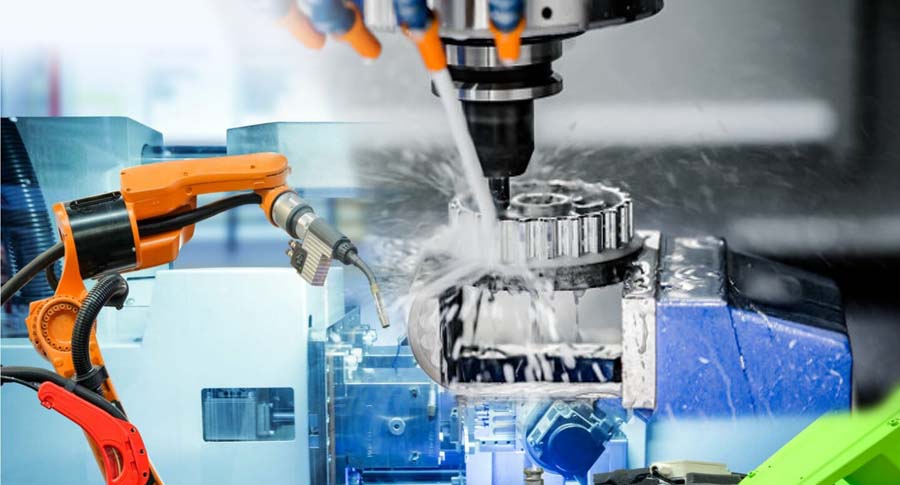The robotics revolution is no longer a distant concept; it’s a present-day reality transforming every sector, from advanced manufacturing and logistics to life-saving medical procedures and deep-space exploration. At the core of every sophisticated robot—whether it’s a collaborative arm, an autonomous vehicle, or a surgical instrument—lies a foundation of precisely engineered mechanical components. These parts are the skeleton and joints that allow complex software and electronics to interact with the physical world.
Unlike standard industrial components, robotic parts are rarely off-the-shelf. They are custom-designed and manufactured to meet a unique set of demanding criteria. This is where the specialized field of custom CNC machining becomes not just a service, but a critical partnership in innovation.
This guide explores the unique demands of machining for robotics, the essential materials and processes involved, and what it takes to manufacture components that enable the next generation of automation.
The Unique Demands of Robotic Components
Machining parts for robotics is a discipline of extremes. It requires a manufacturing approach that prioritizes accuracy, performance, and reliability above all else.
1. Uncompromising Precision and Tight Tolerances
A robot’s primary function is to perform tasks with a high degree of accuracy and repeatability. Any dimensional inaccuracy, however small, can be amplified through the kinematic chain of the robot’s joints, leading to positioning errors, vibration, or backlash (unwanted play in a mechanism). Custom machining is essential to hold the tight tolerances required for bearing fits, gear meshes, and alignment surfaces, ensuring the robot moves exactly as intended, every single time.
2. Complex Geometries for Compact Designs
Robots are a marvel of integration, packing advanced actuators, sensors, and wiring into a compact and efficient form factor. This requires mechanical components with complex, often organic, geometries. Features like lightweighted pockets, contoured surfaces, and intricate internal passages are common. Multi-axis CNC machining, particularly 5-axis milling, is the key enabling technology, allowing for these complex shapes to be machined in a single setup, which maximizes accuracy and efficiency.
3. Advanced Materials for Optimal Performance
Every gram matters in robotics. A lighter component reduces the inertia of the system, allowing for faster acceleration, lower energy consumption, and higher payloads. The goal is always to maximize the strength-to-weight ratio. A specialized machining partner must have deep expertise in working with a range of advanced materials to achieve this balance.
4. Durability for Longevity and Reliability
Robotic components are often subjected to millions of cycles of repetitive motion, stress, and wear. Gears, shafts, grippers (end-effectors), and structural frames must be manufactured to withstand this relentless operation without failure. This requires not only the right material but also precise machining and surface finishing to ensure long-term durability.

Key Materials in Robotic Machining
The choice of material is critical and is dictated by the specific application of the component.
- Aluminum Alloys (6061-T6, 7075-T6): The undisputed workhorse of robotics. Aluminum offers an excellent strength-to-weight ratio, is easily machined, and can be anodized for enhanced durability and corrosion resistance. It is ideal for structural components, chassis, and actuator housings.
- Stainless Steels (303, 316, 17-4 PH): Used where higher strength, hardness, or corrosion resistance is needed. Common for shafts, gears, fasteners, and components used in medical or food-grade robotics.
- Engineering Plastics (PEEK, Delrin, Nylon): Chosen for their unique properties, such as light weight, electrical insulation, and low friction. Ideal for custom bushings, sensor mounts, and non-marring gripper fingers.
- Titanium Alloys: Reserved for high-end applications where weight reduction is absolutely critical without compromising strength, such as in aerospace robotics or high-performance mobile platforms.
- Alloy Steels (e.g., 4140): Selected for high-stress applications like drive shafts and gears that require exceptional toughness and wear resistance after heat treatment.
Essential Machining Processes
A combination of advanced CNC processes is used to create the diverse range of parts a robot requires.
- 5-Axis CNC Milling: The cornerstone for producing complex structural parts. By allowing the tool to approach the workpiece from five different axes simultaneously, it can create intricate contours and angled features in a single clamping, ensuring the highest possible accuracy.
- CNC Turning: Essential for all rotational components. High-precision lathes and turn-mill centers produce shafts, pins, custom fasteners, and joint components with exceptional concentricity and surface finish.
- Turn-Mill Centers: These hybrid machines are invaluable for robotics. They can produce complex parts that require both turning and milling operations (like a shaft with flats or cross-holes) in one continuous process, eliminating the potential for error that comes with multiple setups.
- Surface Finishing: Processes like anodizing (for aluminum), passivation (for stainless steel), and plating are critical final steps. They don’t just provide the desired aesthetic but also enhance surface hardness, wear resistance, and protection against the environment.
Choosing the Right Machining Partner: From Prototype to Production
For a robotics company, a machining supplier is more than a vendor; they are a strategic partner in development and production. Key capabilities to look for include:
- Design for Manufacturability (DfM) Expertise: A great partner provides feedback on your designs to improve their machinability, reduce costs, and enhance performance.
- Advanced Technology and Quality Control: Look for a shop with modern 5-axis machines, turn-mill centers, and robust quality control processes, including CMM (Coordinate Measuring Machine) inspection to verify tolerances.
- Scalability: The ideal partner can seamlessly transition from producing a single rapid prototype for testing to a full production run of hundreds or thousands of identical parts.
- Proven Experience: A track record of producing high-precision components for the robotics, aerospace, or medical industries is a strong indicator of capability.
Conclusion
The incredible advancements in robotics are built upon a physical foundation of precisely manufactured components. Custom CNC machining provides the essential bridge between digital design and real-world performance. As robots become more integrated into our lives, the demand for manufacturers who can deliver complex, lightweight, and ultra-precise components will only continue to grow, driving the future of automation one perfectly machined part at a time.



